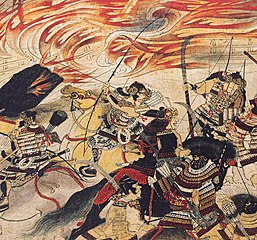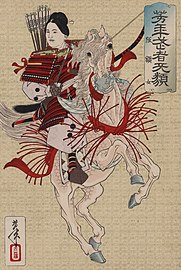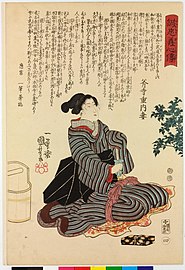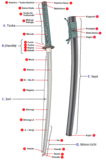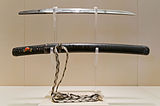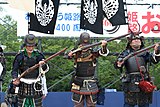Samurai
This article needs additional citations for verification. (September 2021) |

Samurai (侍、さむらい) were the hereditary military nobility[1][2][3][4] and officer caste of medieval and early-modern Japan from the late 12th century until their abolition in the late 1870s during the Meiji era. They were the well-paid retainers of the daimyo, the great feudal landholders. They had high prestige and special privileges.[5]
Following the passing of a law in 1629, samurai on official duty were required to practice daishō (wear two swords).[6] Samurai were granted kiri-sute gomen: the right to kill anyone of a lower class in certain situations. Some important samurai and other figures in Japanese history wanted others to believe all of them engaged combatants using bushido codes of martial virtues and followed various cultural ideals about how a samurai should act.[7]
Although they had predecessors in earlier military and administrative officers, the samurai truly emerged during the Kamakura shogunate, ruling from c.1185 to 1333. They became the ruling political class, with significant power but also significant responsibility. During the 13th century, the samurai proved themselves as adept warriors against the invading Mongols. During the peaceful Edo period, 1603 to 1868, they became the stewards and chamberlains of the daimyo estates, gaining managerial experience and education.
In the 1870s, samurai families comprised 5% of the population. As modern militaries emerged in the 19th century, the samurai were rendered increasingly obsolete and very expensive to maintain compared to the average conscript soldier. The Meiji Restoration ended their feudal roles, and they moved into professional and entrepreneurial roles. Their memory and weaponry remain prominent in Japanese popular culture.
Terminology
In Japanese, historical warriors are usually referred to as bushi (武士, [bɯ.ɕi]), meaning 'warrior', or buke (武家), meaning 'military family'. According to translator William Scott Wilson: "In Chinese, the character 侍 was originally a verb meaning 'to wait upon', 'accompany persons' in the upper ranks of society, and this is also true of the original term in Japanese, saburau. In both countries the terms were nominalized to mean 'those who serve in close attendance to the nobility', the Japanese term saburai being the nominal form of the verb." According to Wilson, an early reference to the word saburai appears in the Kokin Wakashū, the first imperial anthology of poems, completed in the early 900s.[8]
In modern usage, bushi is often used as a synonym for samurai;[9][10][11] however, historical sources make it clear that bushi and samurai were distinct concepts, with the former referring to soldiers or warriors and the latter referring instead to a kind of hereditary nobility.[12][13] The word samurai is now closely associated with the middle and upper echelons of the warrior class. These warriors were usually associated with a clan and their lord, and were trained as officers in military tactics and grand strategy. While these samurai numbered less than 10% of then Japan's population,[14] their teachings can still be found today in both everyday life and in modern Japanese martial arts.
History
Asuka and Nara periods

Following the death of Prince Shōtoku and the victory against the Soga clan, Japan underwent widespread reform. One of the most important was that of the Taika Reform, issued by Emperor Kōtoku in 645. This edict allowed the Japanese aristocracy to adopt the Tang dynasty political structure, bureaucracy, culture, religion, and philosophy.[15] As part of the Taihō Code of 702, and the later Yōrō Code,[16] the population was required to report regularly for the census, a precursor for national conscription. With an understanding of how the population was distributed, Emperor Monmu introduced a law whereby 1 in 3–4 adult males were drafted into the national military. These soldiers were required to supply their own weapons, and in return were exempted from duties and taxes.[15] This was one of the first attempts by the imperial government to form an organized army modeled after the Chinese system. It was called "Gundan-Sei" (ja:軍団制) by later historians and is believed to have been short-lived.[citation needed]
The Taihō Code classified most of the Imperial bureaucrats into 12 ranks, each divided into two sub-ranks, 1st rank being the highest adviser to the emperor. Those of 6th rank and below were referred to as "samurai" and dealt with day-to-day affairs and were initially civilian public servants, in keeping with the original derivation of this word from saburau, a verb meaning 'to serve'.[17][18][19][20] Military men, however, would not be referred to as "samurai" for many more centuries.
Heian period
In the early
Ultimately, Emperor Kanmu disbanded his army. From this time, the emperor's power gradually declined. While the emperor was still the ruler, powerful clans around Kyoto assumed positions as ministers, and their relatives bought positions as magistrates. To amass wealth and repay their debts, magistrates often imposed heavy taxes, resulting in many farmers becoming landless.[citation needed] Through protective agreements and political marriages, the aristocrats accumulated political power, eventually surpassing the traditional aristocracy.[21]
Some clans were originally formed by farmers who had taken up arms to protect themselves from the imperial magistrates sent to govern their lands and collect taxes. These clans formed alliances to protect themselves against more powerful clans.
The Heian period saw the appearance of distinctive
The regency political system by Fujiwara clan and cloistered rule by cloistered emperors
The shoguns of Heian period had no real political power, and the imperial court was in charge of politics. From the mid-9th century to the mid-11th century, the Fujiwara clan controlled political power. They excluded other clans from the political center and monopolized the highest positions in the court, such as Sesshō (摂政, Imperial Regent for Minor Emperors), Kampaku (関白, Imperial Regent fo Adult Emperors), and Daijō-daijin (太政大臣, Chancellor of the Realm), reaching their peak at the end of the 10th century under Fujiwara no Michinaga and Fujiwara no Yorimichi.[25][26][27]
Later, in the mid-11th century,
-
The Gosannen War in the 11th century
Late Heian period and the rise of samurai

During the reigns of Emperor Shirakawa and Emperor Toba, the Taira clan became Kokushi (国司), or overseers of various regions, and accumulated wealth by taking samurai from various regions as their retainers. In the struggle for the succession of Emperor Toba, Emperor Sutoku and Emperor Go-Shirakawa, each with his samurai class on his side, fought the Hōgen rebellion, which was won by Emperor Go-Shirakawa, who had Taira no Kiyomori and Minamoto no Yoshitomo on his side. Later, Taira no Kiyomori defeated Minamoto no Yoshitomo in the Heiji rebellion and became the first samurai-born aristocratic class, eventually becoming Daijō-daijin, the highest position of the aristocratic class, and the Taira clan monopolized important positions at the Imperial Court and wielded power. The victor, Taira no Kiyomori, became an imperial advisor and was the first warrior to attain such a position. He eventually seized control of the central government, establishing the first samurai-dominated government and relegating the emperor to figurehead status. The clan had its women marry emperors and exercise control through the emperor.[28]
-
Heiji rebellion in 1159
-
16th century illustration samurai raiding the house of Minamoto no Yoshitsune
However, when Taira no Kiyomori used his power to have the child of his daughter Taira no Tokuko and Emperor Takakura installed as Emperor Antoku, there was widespread opposition. Prince Mochihito, no longer able to assume the imperial throne, called upon the Minamoto clan to raise an army to defeat the Taira clan, and the Genpei War began. In the midst of the Genpei War, Minamoto no Yoshinaka expelled the Taira clan from Kyoto, and although initially welcomed by the hermit Emperor Go-Shirakawa, he became estranged and isolated due to the disorderly military discipline and lack of political power under his command. He staged a coup, overthrew the emperor's entourage, and became the first of the Minamoto clan to assume the office of Sei-i Taishōgun (shogun). In response, Minamoto no Yoritomo sent Minamoto no Noriyori and Minamoto no Yoshitsune to defeat Yoshinaka, who was killed within a year of becoming shogun. In 1185, the Taira clan was finally defeated in the Battle of Dan-no-ura, and the Minamoto clan came to power.[28][29]
Kamakura shogunate and the Mongol invasions
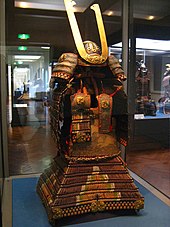
The victorious Minamoto no Yoritomo established the superiority of the samurai over the aristocracy. In 1185, Yoritomo obtained the right to appoint shugo and jitō, and was allowed to organize soldiers and police, and to collect a certain amount of tax.[30] Initially, their responsibility was restricted to arresting rebels and collecting needed army provisions and they were forbidden from interfering with Kokushi officials, but their responsibility gradually expanded. Thus, the samurai class became the political ruling power in Japan.
In 1190 he visited Kyoto and in 1192 became
The
From the Kamakura period onwards, emphasis was put on training samurai from childhood in using "the bow and sword".[33]
In the late Kamakura period, even the most senior samurai began to wear dō-maru, as the heavy and elegant ō-yoroi were no longer respected. Until then, the body was the only part of the dō-maru that was protected, but for higher-ranking samurai, the dō-maru also came with a kabuto (helmet) and shoulder guards.[24] For lower-ranked samurai, the haraate was introduced, the simplest style of armor that protected only the front of the torso and the sides of the abdomen. In the late Kamakura period, a new type of armor called haramaki appeared, in which the two ends of the haraate were extended to the back to provide greater protection.[34]
-
Samurai of the Shōni clan gather to defend against Kublai Khan's Mongolian army during the first Mongol Invasion of Japan, 1274.
-
Battle of Yashima folding screens
Various samurai clans struggled for power during the
In 1274, the Mongol-founded Yuan dynasty in China sent a force of some 40,000 men and 900 ships to invade Japan in northern Kyūshū. Japan mustered a mere 10,000 samurai to meet this threat. The invading army was harassed by major thunderstorms throughout the invasion, which aided the defenders by inflicting heavy casualties. The Yuan army was eventually recalled, and the invasion was called off. The Mongol invaders used small bombs, which was likely the first appearance of bombs and gunpowder in Japan.

The Japanese defenders recognized the possibility of a renewed invasion and began construction of a
Leading up to the second Mongolian invasion, Kublai Khan continued to send emissaries to Japan, with five diplomats sent in September 1275 to Kyūshū. Hōjō Tokimune, the shikken of the Kamakura shogun, responded by having the Mongolian diplomats brought to Kamakura and then beheading them.[35] The graves of the five executed Mongol emissaries exist to this day in Kamakura at Tatsunokuchi.[36] On 29 July 1279, five more emissaries were sent by the Mongol empire, and again beheaded, this time in Hakata. This continued defiance of the Mongol emperor set the stage for one of the most famous engagements in Japanese history.
In 1281, a Yuan army of 140,000 men with 5,000 ships was mustered for another invasion of Japan. Northern Kyūshū was defended by a Japanese army of 40,000 men. The Mongol army was still on its ships preparing for the landing operation when a typhoon hit north Kyūshū island. The casualties and damage inflicted by the typhoon, followed by the Japanese defense of the Hakata Bay barrier, resulted in the Mongols again being defeated.

The thunderstorms of 1274 and the typhoon of 1281 helped the samurai defenders of Japan repel the Mongol invaders despite being vastly outnumbered. These winds became known as kami-no-Kaze, which literally translates as "wind of the gods".[37] This is often given a simplified translation as "divine wind". The kami-no-Kaze lent credence to the Japanese belief that their lands were indeed divine and under supernatural protection.
During this period, the tradition of Japanese swordsmithing developed using laminated or piled steel, a technique dating back over 2,000 years in the Mediterranean and Europe of combining layers of soft and hard steel to produce a blade with a very hard (but brittle) edge, capable of being highly sharpened, supported by a softer, tougher, more flexible spine. The Japanese swordsmiths refined this technique by using multiple layers of steel of varying composition, together with differential heat treatment, or tempering, of the finished blade, achieved by protecting part of it with a layer of clay while quenching (as explained in the article on Japanese swordsmithing). The craft was perfected in the 14th century by the great swordsmith Masamune. The Japanese sword (tachi and katana) became renowned around the world for its sharpness and resistance to breaking.
Nanboku-chō and Muromachi period
In 1336,
From 1346 to 1358 during the Nanboku-cho period, the Ashikaga shogunate gradually expanded the authority of the Shugo (守護), the local military and police officials established by the Kamakura shogunate, giving the Shugo jurisdiction over land disputes between gokenin (御家人) and allowing the Shugo to receive half of all taxes from the areas they controlled. The Shugo shared their newfound wealth with the local samurai, creating a hierarchical relationship between the Shugo and the samurai, and the first early daimyo (大名, feudal lords), called shugo daimyo (守護大名), appeared.[39]

The innovations of Sōshū swordsmiths in the late Kamakura period allowed them to produce Japanese swords with tougher blades than before, and during the Nanboku-chō period, ōdachi (large/great sword) were at their peak as weapons for the samurai.[40]
Until the Mongol invasion in the late Kamakura period, the main battle was fought by small groups of warriors using yumi (bows) from horseback, and close combat was a secondary battle. From the Nanboku-chō period to the Muromachi period, large groups of infantrymen became more active in battle, close combat became more important, and the naginata and tachi, which had been used since the Heian period, were used more. The yari (spear) was not yet a major weapon in this period.[41][42]
During the Nanboku-chō period, many lower-class foot soldiers called ashigaru began to participate in battles, and the popularity of haramaki increased. During the Nanboku-chō and Muromachi periods, dō-maru and haramaki became the norm, and senior samurai also began to wear haramaki by adding kabuto (helmet), men-yoroi (face armor), and gauntlet.[43]
Issues of inheritance caused family strife as primogeniture became common, in contrast to the division of succession designated by law before the 14th century. Invasions of neighboring samurai territories became common to avoid infighting, and bickering among samurai was a constant problem for the Kamakura and Ashikaga shogunates.
Sengoku period
The outbreak of the


Daimyo who became more powerful as the shogunate's control weakened were called sengoku daimyo (戦国大名), and they often came from shugo daimyo, Shugodai (守護代, deputy Shugo), and kokujin or kunibito (国人, local masters). In other words, sengoku daimyo differed from shugo daimyo in that sengoku daimyo was able to rule the region on his own, without being appointed by the shogun.[39]
During this period, the traditional master-servant relationship between the lord and his vassals broke down, with the vassals eliminating the lord, internal clan and vassal conflicts over leadership of the lord's family, and frequent rebellion and puppetry by branch families against the lord's family.[46] These events sometimes led to the rise of samurai to the rank of sengoku daimyo. For example, Hōjō Sōun was the first samurai to rise to the rank of sengoku daimyo during this period. Uesugi Kenshin was examples of Shugodai who became sengoku daimyo by weakening and eliminating the power of their lords.[47][48]
This period was marked by the loosening of samurai culture, with people born into other social strata sometimes making a name for themselves as warriors and thus becoming
From this time on, infantrymen called ashigaru, who were mobilized from the peasantry, were mobilized in even greater numbers than before, and the importance of the infantry, which had begun in the Nanboku-chō period, increased even more.[41] When matchlocks were introduced from Portugal in 1543, Japanese swordsmiths immediately began to improve and mass-produce them. The Japanese matchlock was named tanegashima after the Tanegashima island, which is believed to be the place where it was first introduced to Japan. By the end of the Sengoku Period, there were hundreds of thousands of rifles in Japan and a large army of nearly 100,000 men clashing with each other.[50]
On the battlefield, ashigaru began to fight in close formation, using yari (spear) and tanegashima. As a result, yari, yumi (bow), and tanegashima became the primary weapons on the battlefield. The naginata, which was difficult to maneuver in close formation, and the long, heavy tachi fell into disuse and were replaced by the nagamaki, which could be held short, and the short, light katana, which appeared in the Nanboku-cho period and gradually became more common. The tachi was often cut off from the hilt and shortened to make a katana. The tachi, which had become inconvenient for use on the battlefield, was transformed into a symbol of authority carried by high-ranking samurai.[51][52][53][41] Although the ōdachi had become even more obsolete, some sengoku daimyo dared to organize assault and kinsmen units composed entirely of large men equipped with ōdachi to demonstrate the bravery of their armies.[54]
These changes in the aspect of the battlefield during the Sengoku period led to the emergence of the tosei-gusoku style of armor, which improved the productivity and durability of armor. In the history of Japanese armor, this was the most significant change since the introduction of the ō-yoroi and dō-mal in the Heian period. In this style, the number of parts was reduced, and instead armor with eccentric designs became popular.[55]
In the Sengoku period privileges given to the samurai, combined with the already existing ones from the Muromachi period and the changes to society in both periods, allowed for much autonomy on their part.[56] Samurai could and did murder, both for fun, as displayed through abuse of their peasants[57] and sometimes even total strangers,[58] or to advance their status to become figures of fear,[59] as seen with the phenomenon of samurai being allowed to murder their own family members and personal servants, and sometimes lower-ranking samurai and nobles in their lord's land, to gain more power and stop certain children from inheriting land.[56] Feuds between samurai in opposing factions or even the same factions[60][61][56] were seen as a natural extension of this right of power and dominion.[56]
By the end of the Sengoku period, allegiances between warrior vassals, also known as military retainers, and lords were solidified.
Azuchi–Momoyama period

The Azuchi-Momoyama period refers to the period when
Oda, Toyotomi, and Tokugawa

Oda Nobunaga was the well-known lord of the Nagoya area (once called Owari Province) and an exceptional example of a samurai of the Sengoku period.[64] He came within a few years of, and laid down the path for his successors to follow, the reunification of Japan under a new bakufu (shogunate).
Oda Nobunaga made innovations in the fields of organization and war tactics, made heavy use of arquebuses, developed commerce and industry, and treasured innovation. Consecutive victories enabled him to realize the termination of the Ashikaga Bakufu and the disarmament of the military powers of the Buddhist monks, which had inflamed futile struggles among the populace for centuries. Attacking from the "sanctuary" of Buddhist temples, they were constant headaches to any warlord and even the emperor who tried to control their actions. He died in 1582 when one of his generals, Akechi Mitsuhide, turned upon him with his army.

Toyotomi Hideyoshi and Tokugawa Ieyasu, who founded the Tokugawa shogunate, were loyal followers of Nobunaga. Hideyoshi began as a peasant and became one of Nobunaga's top generals, and Ieyasu had shared his childhood with Nobunaga. Hideyoshi defeated Mitsuhide within a month and was regarded as the rightful successor of Nobunaga by avenging the treachery of Mitsuhide. These two were able to use Nobunaga's previous achievements on which build a unified Japan and there was a saying: "The reunification is a rice cake; Oda made it. Hashiba shaped it. In the end, only Ieyasu tastes it."[65] (Hashiba is the family name that Toyotomi Hideyoshi used while he was a follower of Nobunaga.)
Toyotomi Hideyoshi, who became a grand minister in 1586, created a law that non-samurai were not allowed to carry weapons, which the samurai caste codified as permanent and hereditary, thereby ending the social mobility of Japan, which lasted until the dissolution of the Edo shogunate by the Meiji revolutionaries.
The distinction between samurai and non-samurai was so obscure that during the 16th century, most male adults in any social class (even small farmers) belonged to at least one military organization of their own and served in wars before and during Hideyoshi's rule. It can be said that an "all against all" situation continued for a century. The authorized samurai families after the 17th century were those that chose to follow Nobunaga, Hideyoshi and Ieyasu. Large battles occurred during the change between regimes, and a number of defeated samurai were destroyed, went rōnin or were absorbed into the general populace.
Invasions of Korea

In 1592 and again in 1597, Toyotomi Hideyoshi, aiming to invade China through Korea, mobilized an army of 160,000 peasants and samurai and deployed them to Korea in one of the largest military endeavors in Eastern Asia until the late 19th century.[66][67] Taking advantage of arquebus mastery and extensive wartime experience from the Sengoku period, Japanese samurai armies made major gains in most of Korea. A few of the famous samurai generals of this war were Katō Kiyomasa, Konishi Yukinaga, and Shimazu Yoshihiro. Katō Kiyomasa advanced to Orangkai territory (present-day Manchuria) bordering Korea to the northeast and crossed the border into northern China.
Kiyomasa withdrew back to Korea after retaliatory counterattacks from the Jurchens in the area, whose castles his forces had raided.[68] Shimazu Yoshihiro led some 7,000 samurai into battle, and despite being heavily outnumbered, defeated a host of allied Ming and Korean forces at the Battle of Sacheon in 1598. Yoshihiro was feared as Oni-Shimazu ("Shimazu ogre") and his nickname spread across Korea and into China.

In spite of the superiority of Japanese land forces, the two expeditions ultimately failed after Hideyoshi's death,[69] though the invasions did devastate the Korean peninsula. The causes of the failure included Korean naval superiority (which, led by Admiral Yi Sun-sin, harassed Japanese supply lines continuously throughout the wars, resulting in supply shortages on land), the commitment of sizable Ming forces to Korea, Korean guerrilla actions, wavering Japanese commitment to the campaigns as the wars dragged on, and the underestimation of resistance by Japanese commanders.
In the first campaign of 1592, Korean defenses on land were caught unprepared, under-trained, and under-armed. They were rapidly overrun, with only a limited number of successfully resistant engagements against the more experienced and battle-hardened Japanese forces. During the second campaign in 1597, Korean and Ming forces proved far more resilient and with the support of continued Korean naval superiority, managed to limit Japanese gains to parts of southeastern Korea. The final death blow to the Japanese campaigns in Korea came with Hideyoshi's death in late 1598 and the recall of all Japanese forces in Korea by the Council of Five Elders, established by Hideyoshi to oversee the transition from his regency to that of his son Hideyori.
Battle of Sekigahara

Before his death, Hideyoshi ordered that Japan be ruled by a council of the five most powerful sengoku daimyo, Go-Tairō (五大老, Council of Five Elders), and Hideyoshi's five retainers, Go-Bugyō (五奉行, Five Commissioners), until his only heir, the five-year-old Toyotomi Hideyori, reached the age of 16.[70] However, having only the young Hideyori as Hideyoshi's successor weakened the Toyotomi regime. Today, the loss of all of Hideyoshi's adult heirs is considered the main reason for the downfall of the Toyotomi clan.[71][72][73] Hideyoshi's younger brother, Toyotomi Hidenaga, who had supported Hideyoshi's rise to power as a leader and strategist, had already died of illness in 1591, and his nephew, Toyotomi Hidetsugu, who was Hideyoshi's only adult successor, was forced to commit seppuku in 1595 along with many other vassals on Hideyoshi's orders for suspected rebellion.[71][72][73]
In this politically unstable situation, Maeda Toshiie, one of the Gotairō, died of illness, and Tokugawa Ieyasu, one of the Gotairō' who had been second in power to Hideyoshi but had not participated in the war, rose to power, and Ieyasu came into conflict with Ishida Mitsunari, one of the Go-Bukyō and others. This conflict eventually led to the Battle of Sekigahara, in which the Tō-gun (東軍, Eastern Army) led by Ieyasu defeated the Sei-gun (西軍, Western Army) led by Mitsunari, and Ieyasu nearly gained control of Japan.[70]
Social mobility was high, as the ancient regime collapsed and emerging samurai needed to maintain a large military and administrative organizations in their areas of influence. Most of the samurai families that survived to the 19th century originated in this era, declaring themselves to be the blood of one of the four ancient noble clans:
. In most cases, however, it is difficult to prove these claims.Tokugawa shogunate
After the Battle of Sekigahara, when the Tokugawa shogunate defeated the Toyotomi clan at summer campaign of the Siege of Osaka in 1615, the long war period ended. During the Tokugawa shogunate, samurai increasingly became courtiers, bureaucrats, and administrators rather than warriors. With no warfare since the early 17th century, samurai gradually lost their military function during the Tokugawa era (also called the Edo period).
By the end of the Tokugawa era, samurai were aristocratic bureaucrats for the daimyōs, with their daishō, the paired long and short swords of the samurai (cf. katana and wakizashi) becoming more of a symbolic emblem of power rather than a weapon used in daily life. They still had the legal right to cut down any commoner who did not show proper respect kiri-sute gomen (斬り捨て御免), but to what extent this right was used is unknown. When the central government forced daimyōs to cut the size of their armies, unemployed rōnin became a social problem.
Theoretical obligations between a samurai and his lord (usually a daimyō) increased from the Genpei era to the Edo era. They were strongly emphasized by the teachings of Confucius and Mencius, which were required reading for the educated samurai class. The leading figures who introduced Confucianism in Japan in the early Tokugawa period were Fujiwara Seika (1561–1619), Hayashi Razan (1583–1657), and Matsunaga Sekigo (1592–1657).
The conduct of samurai served as role model behavior for the other social classes.[74] With time on their hands, samurai spent more time in pursuit of other interests such as becoming scholars.After the Edo period, it came to cover all of society, and although the shogunate sometimes invited monks as advisors, the nobility was excluded from the government. As a result, samurai began to assume all civilian roles, and from the Edo period onwards, samurai shifted their activities from military to political administration. In addition, those who were newly promoted to the shogunate or domain in recognition of talents unrelated to martial arts, such as literature and scholarship, were also given the status of samurai. It can be said that the difference between a samurai and a military officer appears in such a place. In the Edo Shogunate, samurai equivalent to civil servants and administrative officers were called "officials" Samurai were given an honorific title and were called 'Obuke-sama'.[citation needed]
Samurai in Southeast Asia
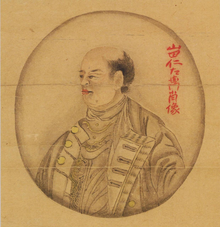
In the late 1500s, trade between Japan and Southeast Asia accelerated and increased exponentially when the Tokugawa shogunate was established in the early 1600s. The destinations of the trading ships, the red seal ships, were Thailand, the Philippines, Vietnam, Cambodia, etc. Many Japanese moved to Southeast Asia and established Japanese towns there. Many samurai, or rōnin, who had lost their masters after the battle of Sekigahara, lived in the Japanese towns. The Spaniards in the Philippines, the Dutch of the Dutch East India Company, and the Thais of the Ayutthaya Kingdom saw the value of these samurai as mercenaries and recruited them. The most famous of these mercenaries was Yamada Nagamasa. He was originally a palanquin bearer who belonged to the lowest end of the samurai class, but he rose to prominence in the Ayutthaya Kingdom, now in southern Thailand, and became governor of the Nakhon Si Thammarat Kingdom. When the policy of national isolation (sakoku) was established in 1639, trade between Japan and Southeast Asia ceased, and records of Japanese activities in Southeast Asia were lost for many years after 1688.[75][76][77]
Samurai as diplomatic ambassadors
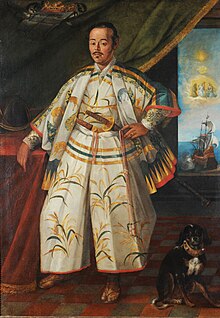
In 1582, three
In 1612,
At the end of the Edo period (
Modernization
The relative peace of the Tokugawa era was shattered with the arrival of Commodore
From 1854, the samurai army and the navy were modernized. A
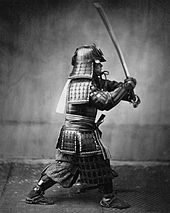
The last showing of the original samurai was in 1867 when samurai from Chōshū and Satsuma provinces defeated the shogunate forces in favor of the rule of the emperor in the Boshin War. The two provinces were the lands of the daimyōs that submitted to Ieyasu after the Battle of Sekigahara in 1600.
Dissolution
In the 1870s, samurai comprised five percent of the population, or 400,000 families with about 1.9 million members. They came under direct national jurisdiction in 1869, and of all the classes during the Meiji revolution they were the most affected.[81] Although many lesser samurai had been active in the Meiji restoration, the older ones represented an obsolete feudal institution that had a practical monopoly of military force, and to a large extent of education as well. A priority of the Meiji government was to gradually abolish the entire class of samurai and integrate them into the Japanese professional, military and business classes.[82]
Their traditional guaranteed salaries were very expensive, and in 1873 the government started taxing the stipends and began to transform them into interest-bearing government bonds; the process was completed in 1879. The main goal was to provide enough financial liquidity to enable former samurai to invest in land and industry. A military force capable of contesting not just China but the imperial powers required a large conscript army that closely followed Western standards. The notion of very strict obedience to chain of command was incompatible with the individual authority of the samurai. Samurai now became
Younger samurai often became exchange students because they were ambitious, literate and well-educated. On return, some started private schools for higher education, while many samurai became reporters and writers and set up newspaper companies.[84] Others entered governmental service.[85] In the 1880s, 23 percent of prominent Japanese businessmen were from the samurai class; by the 1920s the number had grown to 35 percent.[86]
Philosophy
Religious influences
The philosophies of Confucianism,[62] Buddhism and Zen, and to a lesser extent Shinto, influenced the samurai culture. Zen meditation became an important teaching because it offered a process to calm one's mind. The Buddhist concept of reincarnation and rebirth led samurai to abandon torture and needless killing, while some samurai even gave up violence altogether and became Buddhist monks after coming to believe that their killings were fruitless. Some were killed as they came to terms with these conclusions in the battlefield. The most defining role that Confucianism played in samurai philosophy was to stress the importance of the lord-retainer relationship—the loyalty that a samurai was required to show his lord.[citation needed]
Literature on the subject of bushido such as Hagakure ("Hidden in Leaves") by Yamamoto Tsunetomo and Gorin no Sho ("Book of the Five Rings") by Miyamoto Musashi, both written in the Edo period, contributed to the development of bushidō and Zen philosophy.
According to Robert Sharf, "The notion that Zen is somehow related to Japanese culture in general, and bushidō in particular, is familiar to Western students of Zen through the writings of D. T. Suzuki, no doubt the single most important figure in the spread of Zen in the West."
In the first place, the nation with which we have had to do here surpasses in goodness any of the nations lately discovered. I really think that among barbarous nations there can be none that has more natural goodness than the Japanese. They are of a kindly disposition, not at all given to cheating, wonderfully desirous of honour and rank. Honour with them is placed above everything else. There are a great many poor among them, but poverty is not a disgrace to any one. There is one thing among them of which I hardly know whether it is practised anywhere among Christians. The nobles, however poor they may be, receive the same honour from the rest as if they were rich.[88]
Doctrine

In the 13th century, Hōjō Shigetoki wrote: "When one is serving officially or in the master's court, he should not think of a hundred or a thousand people, but should consider only the importance of the master."[89] Carl Steenstrup notes that 13th- and 14th-century warrior writings (gunki) "portrayed the bushi in their natural element, war, eulogizing such virtues as reckless bravery, fierce family pride, and selfless, at times senseless devotion of master and man".[90]
Feudal lords such as Shiba Yoshimasa (1350–1410) stated that a warrior looked forward to a glorious death in the service of a military leader or the emperor:
It is a matter of regret to let the moment when one should die pass by ... First, a man whose profession is the use of arms should think and then act upon not only his own fame, but also that of his descendants. He should not scandalize his name forever by holding his one and only life too dear ... One's main purpose in throwing away his life is to do so either for the sake of the Emperor or in some great undertaking of a military general. It is that exactly that will be the great fame of one's descendants.[91]

In 1412, Imagawa Sadayo wrote a letter of admonishment to his brother stressing the importance of duty to one's master. Imagawa was admired for his balance of military and administrative skills during his lifetime, and his writings became widespread. The letters became central to Tokugawa-era laws and became required study material for traditional Japanese until World War II:[92]
First of all, a samurai who dislikes battle and has not put his heart in the right place even though he has been born in the house of the warrior, should not be reckoned among one's retainers ... It is forbidden to forget the great debt of kindness one owes to his master and ancestors and thereby make light of the virtues of loyalty and filial piety ... It is forbidden that one should ... attach little importance to his duties to his master ... There is a primary need to distinguish loyalty from disloyalty and to establish rewards and punishments.[93]
Similarly, the feudal lord Takeda Nobushige (1525–1561) stated:
In matters both great and small, one should not turn his back on his master's commands ... One should not ask for gifts or enfiefments from the master ... No matter how unreasonably the master may treat a man, he should not feel disgruntled ... An underling does not pass judgments on a superior.[94]
Nobushige's brother Takeda Shingen (1521–1573) also made similar observations:
One who was born in the house of a warrior, regardless of his rank or class, first acquaints himself with a man of military feats and achievements in loyalty ... Everyone knows that if a man doesn't hold filial piety toward his own parents he would also neglect his duties toward his lord. Such a neglect means a disloyalty toward humanity. Therefore such a man doesn't deserve to be called 'samurai'.[95]
The feudal lord Asakura Yoshikage (1428–1481) wrote: "In the fief of the Asakura, one should not determine hereditary chief retainers. A man should be assigned according to his ability and loyalty." Asakura also observed that the successes of his father were obtained by the kind treatment of the warriors and common people living in domain. By his civility, "all were willing to sacrifice their lives for him and become his allies."[96]
Katō Kiyomasa was one of the most powerful and well-known lords of the Sengoku period. He commanded most of Japan's major clans during the invasion of Korea. In a handbook he addressed to "all samurai, regardless of rank", he told his followers that a warrior's only duty in life was to "grasp the long and the short swords and to die". He also ordered his followers to put forth great effort in studying the military classics, especially those related to loyalty and filial piety. He is best known for his quote:[97] "If a man does not investigate into the matter of Bushido daily, it will be difficult for him to die a brave and manly death. Thus it is essential to engrave this business of the warrior into one's mind well."

It is not the Way of the Warrior [i.e., bushidō] to be shamed and avoid death even under circumstances that are not particularly important. It goes without saying that to sacrifice one's life for the sake of his master is an unchanging principle. That I should be able to go ahead of all the other warriors of this country and lay down my life for the sake of my master's benevolence is an honor to my family and has been my most fervent desire for many years.
It is said that both men cried when they parted ways, because they knew they would never see each other again. Torii's father and grandfather had served the Tokugawa before him, and his own brother had already been killed in battle. Torii's actions changed the course of Japanese history. Ieyasu Tokugawa successfully raised an army and won at
The translator of Hagakure, William Scott Wilson, observed examples of warrior emphasis on death in clans other than Yamamoto's: "he (Takeda Shingen) was a strict disciplinarian as a warrior, and there is an exemplary story in the Hagakure relating his execution of two brawlers, not because they had fought, but because they had not fought to the death".[102][103]
The rival of Takeda Shingen (1521–1573) was Uesugi Kenshin (1530–1578), a legendary Sengoku warlord well versed in the Chinese military classics and who advocated the "way of the warrior as death". Japanese historian Daisetz Teitaro Suzuki describes Uesugi's beliefs as:
Those who are reluctant to give up their lives and embrace death are not true warriors ... Go to the battlefield firmly confident of victory, and you will come home with no wounds whatever. Engage in combat fully determined to die and you will be alive; wish to survive in the battle and you will surely meet death. When you leave the house determined not to see it again you will come home safely; when you have any thought of returning you will not return. You may not be in the wrong to think that the world is always subject to change, but the warrior must not entertain this way of thinking, for his fate is always determined.[104]
Families such as the Imagawa were influential in the development of warrior ethics and were widely quoted by other lords during their lifetime. The writings of Imagawa Sadayo were highly respected and sought out by Tokugawa Ieyasu as the source of Japanese feudal law.

Historian H. Paul Varley notes the description of Japan given by Jesuit leader
Arts
In December 1547, Francis was in Malacca (Malaysia) waiting to return to Goa (India) when he met a low-ranked samurai named Anjiro (possibly spelled "Yajiro"). Anjiro was not an intellectual, but he impressed Xavier because he took careful notes of everything he said in church. Xavier made the decision to go to Japan in part because this low-ranking samurai convinced him in Portuguese that the Japanese people were highly educated and eager to learn. They were hard workers and respectful of authority. In their laws and customs they were led by reason, and, should the Christian faith convince them of its truth, they would accept it en masse.[106]
By the 12th century, upper-class samurai were highly literate because of the general introduction of Confucianism from China during the 7th to 9th centuries and in response to their perceived need to deal with the imperial court, who had a monopoly on culture and literacy for most of the Heian period. As a result, they aspired to the more cultured abilities of the nobility.[107]
Examples such as Taira Tadanori (a samurai who appears in the Heike Monogatari) demonstrate that warriors idealized the arts and aspired to become skilled in them. Tadanori was famous for his skill with the pen and the sword or the "bun and the bu", the harmony of fighting and learning.
Samurai were expected to be cultured and literate and admired the ancient saying "bunbu-ryōdō" (文武両道, literary arts, military arts, both ways) or "The pen and the sword in accord". By the time of the Edo period, Japan had a higher literacy comparable to that in central Europe.[108]
The number of men who actually achieved the ideal and lived their lives by it was high. An early term for warrior, "uruwashii", was written with a kanji that combined the characters for literary study ("bun" 文) and military arts ("bu" 武), and is mentioned in the Heike Monogatari (late 12th century). The Heike Monogatari makes reference to the educated poet-swordsman ideal in its mention of Taira no Tadanori's death:[109]
Friends and foes alike wet their sleeves with tears and said,
What a pity! Tadanori was a great general,
pre-eminent in the arts of both sword and poetry.
In his book "Ideals of the Samurai" translator William Scott Wilson states:
The warriors in the Heike Monogatari served as models for the educated warriors of later generations, and the ideals depicted by them were not assumed to be beyond reach. Rather, these ideals were vigorously pursued in the upper echelons of warrior society and recommended as the proper form of the Japanese man of arms. With the Heike Monogatari, the image of the Japanese warrior in literature came to its full maturity.[109]
Wilson then translates the writings of several warriors who mention the Heike Monogatari as an example for their men to follow.
A number of warrior writings document this ideal from the 13th century onward. Most warriors aspired to or followed this ideal to varying degrees.[110]
Culture
As aristocrats for centuries, samurai developed their own cultures that influenced Japanese culture as a whole.
Until the 17th century, samurai and other soldiers were widely hated, feared, or disdained by commoners and their village cultures, where pacifist movements flourished.[57] Writers and artists who were either commoners or sympathized with them[citation needed] often cast the armies and the nobility structures of when they were writing in a bad light because of this.[57] In war and peace,[59] samurai and other soldiers sometimes engaged in behavior similar to European free companies during peacetime,[58] stirring up anti-elite tensions after village raids and thievery,[57] as well as behavior viewed by commoners as cowardly or dishonorable, similar to common cultural views of ninjas.
The culture associated with the samurai such as the tea ceremony, monochrome ink painting, rock gardens and poetry was adopted by warrior patrons throughout the centuries 1200–1600. These practices were adapted from the Chinese arts. Zen monks introduced them to Japan and they were allowed to flourish due to the interest of powerful warrior elites.
Education
In general, samurai, aristocrats, and priests had a very high literacy rate in kanji. Recent studies have shown that literacy in kanji among other groups in society was somewhat higher than previously understood. For example, court documents, birth and death records and marriage records from the Kamakura period, submitted by farmers, were prepared in Kanji. Both the kanji literacy rate and skills in math improved toward the end of Kamakura period.[107]
Some samurai had buke bunko, or "warrior library", a personal library that held texts on strategy, the science of warfare, and other documents that would have proved useful during the warring era of feudal Japan. One such library held 20,000 volumes. The upper class had Kuge bunko, or "family libraries", that held classics, Buddhist sacred texts, and family histories, as well as genealogical records.[112]
Literacy was generally high among the warriors and the common classes as well. The feudal lord Asakura Norikage (1474–1555 AD) noted the great loyalty given to his father, due to his polite letters, not just to fellow samurai, but also to the farmers and townspeople:
There were to Lord Eirin's character many high points difficult to measure, but according to the elders the foremost of these was the way he governed the province by his civility. It goes without saying that he acted this way toward those in the samurai class, but he was also polite in writing letters to the farmers and townspeople, and even in addressing these letters he was gracious beyond normal practice. In this way, all were willing to sacrifice their lives for him and become his allies.[113]
In a letter dated 29 January 1552,
There are two kinds of writing in Japan, one used by men and the other by women; and for the most part both men and women, especially of the nobility and the commercial class, have a literary education. The bonzes, or bonzesses, in their monasteries teach letters to the girls and boys, though rich and noble persons entrust the education of their children to private tutors.
Most of them can read, and this is a great help to them for the easy understanding of our usual prayers and the chief points of our holy religion.[114]
In a letter to Father Ignatius Loyola at Rome, Xavier further noted the education of the upper classes:
The Nobles send their sons to monasteries to be educated as soon as they are 8 years old, and they remain there until they are 19 or 20, learning reading, writing and religion; as soon as they come out, they marry and apply themselves to politics. They are discreet, magnanimous and lovers of virtue and letters, honouring learned men very much.
In a letter dated 11 November 1549, Xavier described a multi-tiered educational system in Japan consisting of "universities", "colleges", "academies" and hundreds of monasteries that served as a principal center for learning by the populace:
But now we must give you an account of our stay at Cagoxima. We put into that port because the wind was adverse to our sailing to Meaco, which is the largest city in Japan, and most famous as the residence of the King and the Princes. It is said that after four months are passed the favourable season for a voyage to Meaco will return, and then with the good help of God we shall sail thither. The distance from Cagoxima is three hundred leagues. We hear wonderful stories about the size of Meaco: they say that it consists of more than ninety thousand dwellings. There is a very famous University there, as well as five chief colleges of students, and more than two hundred monasteries of bonzes, and of others who are like coenobites, called Legioxi, as well as of women of the same kind, who are called Hamacutis. Besides this of Meaco, there are in Japan five other principal academies, at Coya, at Negu, at Fisso, and at Homia. These are situated round Meaco, with short distances between them, and each is frequented by about three thousand five hundred scholars. Besides these there is the Academy at Bandou, much the largest and most famous in all Japan, and at a great distance from Meaco. Bandou is a large territory, ruled by six minor princes, one of whom is more powerful than the others and is obeyed by them, being himself subject to the King of Japan, who is called the Great King of Meaco. The things that are given out as to the greatness and celebrity of these universities and cities are so wonderful as to make us think of seeing them first with our own eyes and ascertaining the truth, and then when we have discovered and know how things really are, of writing an account of them to you. They say that there are several lesser academies besides those which we have mentioned.
Names
A samurai was usually named by combining one kanji from his father or grandfather and one new kanji. Samurai normally used only a small part of their total name.
For example, the full name of
Samurai were given the privilege of carrying two swords and using 'samurai surnames' to identify themselves from the common people.[115]
Marriage

Samurai had arranged marriages, which were arranged by a go-between of the same or higher rank. While for those samurai in the upper ranks this was a necessity (as most had few opportunities to meet women), this was a formality for lower-ranked samurai. Most samurai married women from a samurai family, but for lower-ranked samurai, marriages with commoners were permitted. In these marriages a dowry was brought by the woman and was used to set up the couple's new household.
A samurai could take
A samurai could divorce his wife for a variety of reasons with approval from a superior, but divorce was, while not entirely nonexistent, a rare event. A wife's failure to produce a son was cause for divorce, but adoption of a male heir was considered an acceptable alternative to divorce. A samurai could divorce for personal reasons, even if he simply did not like his wife, but this was generally avoided as it would embarrass the person who had arranged the marriage. A woman could also arrange a divorce, although it would generally take the form of the samurai divorcing her. After a divorce, samurai had to return the betrothal money, which often prevented divorces.
Culture of the Iga and Koga clans
The leaders of the Iga and Koga clan shinobi were samurai,[116] and cultivated ideas about secretive tactics for centuries to become leaders of mercenaries for nobles to pay and use.
Women

Maintaining the household was the main duty of women of the samurai class. This was especially crucial during early feudal Japan, when warrior husbands were often traveling abroad or engaged in clan battles. The wife, or okugatasama (meaning: one who remains in the home), was left to manage all household affairs, care for the children, and perhaps even defend the home forcibly. For this reason, many women of the samurai class were trained in wielding a polearm called a naginata or a special knife called the kaiken in an art called tantojutsu (lit. the skill of the knife), which they could use to protect their household, family, and honor if the need arose. There were women who actively engaged in battles alongside male samurai in Japan, although most of these female warriors were not formal samurai.[117]
A samurai's daughter's greatest duty was
Traits valued in women of the samurai class were humility, obedience, self-control, strength, and loyalty. Ideally, a samurai wife would be skilled at managing property, keeping records, dealing with financial matters, educating the children (and perhaps servants as well), and caring for elderly parents or in-laws that may be living under her roof. Confucian law, which helped define personal relationships and the code of ethics of the warrior class, required that a woman show subservience to her husband, filial piety to her parents, and care to the children. Too much love and affection was also said to indulge and spoil the youngsters. Thus, a woman was also to exercise discipline.
Though women of wealthier samurai families enjoyed perks of their elevated position in society, such as avoiding the physical labor that those of lower classes often engaged in, they were still viewed as far beneath men. Women were prohibited from engaging in any political affairs and were usually not the heads of their household. This does not mean that women in the samurai class were always powerless. Powerful women both wisely and unwisely wielded power at various occasions. Throughout history, several women of the samurai class have acquired political power and influence, even though they have not received these privileges de jure.
After
As the Tokugawa period progressed more value became placed on education, and the education of females beginning at a young age became important to families and society as a whole. Marriage criteria began to weigh intelligence and education as desirable attributes in a wife, right along with physical attractiveness. Though many of the texts written for women during the Tokugawa period only pertained to how a woman could become a successful wife and household manager, there were those that undertook the challenge of learning to read, and also tackled philosophical and literary classics. Nearly all women of the samurai class were literate by the end of the Tokugawa period.
-
Japanese woman preparing forritual suicide
-
Yuki no Kata defending Tsu Castle. 18th century
-
A samurai class woman
Foreign samurai

Several people born in foreign countries were granted the title of samurai.
After
The English sailor and adventurer
Italian
Weapons
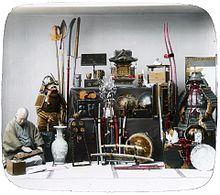
- Japanese swords are the weapons that have come to be synonymous with the samurai. Chokutō, swords from the Nara period, featured a straight blade. By 900, curved tachi appeared, and ultimately the katana. Smaller commonly known companion swords are the wakizashi and the tantō.[124] Wearing a long sword (katana or tachi) together with a smaller sword became the symbol of the samurai, and this combination of swords is referred to as a daishō (literally "big and small"). During the Edo period only samurai were allowed to wear a daisho. A longer blade known as the nodachi was also used in the fourteenth century, though primarily used by samurai on the ground.[125]
- The yumi (longbow), reflected in the art of kyūjutsu (lit. the skill of the bow) was a major weapon of the Japanese military. Its usage declined with the introduction of the tanegashima (Japanese matchlock) during the Sengoku period, but the skill was still practiced at least for sport.[126] The yumi, an asymmetric composite bow made from bamboo, wood, rattan and leather, had an effective range of 50 or 100 meters (160 or 330 feet) if accuracy was not an issue. On foot, it was usually used behind a tate (手盾), a large, mobile wooden shield, but the yumi could also be used from horseback because of its asymmetric shape. The practice of shooting from horseback became a Shinto ceremony known as yabusame (流鏑馬).[127]
- Pole weapons including the yari (spear) and naginata were commonly used by the samurai. The yari displaced the naginata from the battlefield as personal bravery became less of a factor and battles became more organized around massed, inexpensive foot troops (ashigaru).[128] A charge, mounted or dismounted, was also more effective when using a spear rather than a sword, as it offered better than even odds against a samurai using a sword. In the Battle of Shizugatake where Shibata Katsuie was defeated by Toyotomi Hideyoshi, seven samurai who came to be known as the "Seven Spears of Shizugatake" (賤ヶ岳七本槍) played a crucial role in the victory.[129]
- Tanegashima were introduced to Japan in 1543 through Portuguese trade. Tanegashima were produced on a large scale by Japanese gunsmiths, enabling warlords to raise and train armies from masses of peasants. The new weapons were highly effective; their ease of use and deadly effectiveness led to the tanegashima becoming the weapon of choice over the yumi. By the end of the 16th century, there were more firearms in Japan than in many European nations. Tanegashima—employed en masse, largely by ashigaru peasant foot troops—were responsible for a change in military tactics that eventually led to establishment of the Tokugawa shogunate and an end to civil war. Production of tanegashima declined sharply as there was no need for massive amounts of firearms. During the Edo period, tanegashima were stored away and used mainly for hunting and target practice. Foreign intervention in the 19th century renewed interest in firearms, but the tanegashima was outdated by then, and various samurai factions purchased more modern firearms from European sources.[130]
- Arima clan of Kyushu used cannon like this at the Battle of Okinawate against the Ryūzōji clan.
- Staff weapons of many shapes and sizes made from oak and other hard woods were used by the samurai, commonly known ones include the bō, the jō, the hanbō, and the tanbō.
- jutte were one-handed weapons, and others like the kanabōwere large two-handed weapons.
- Chain weapons, various weapons using chains were used during the samurai era, the kusarigama and kusari-fundo are examples.
-
Cross sections of Japanese sword lamination methods
-
Diagram of the katana sword
-
Samurai with various armor and weapons, c. 1802–1814
-
Antique Japanese tachi
-
Antique Japanese wakizashi
-
Antique Japanese wakizashi
-
Reenactors withTanegashimaat Himeji Castle Festival
-
Japanese arrow stand with a pair of Yumi bows.
-
The bow of the Kamakura period
-
The arrow of the Kamakura period
-
A naginata blade from the Kamakura period
-
Three yari (Kagi yari, omi yari and su yari) mounted in koshirae
Armor

As far back as the seventh century Japanese warriors wore a form of
In the 16th century a new type of armor started to become popular after the advent of firearms, new fighting tactics by increasing the scale of battles and the need for additional protection and high productivity. The kozane dou, which was made of small individual scales, was replaced by itazane, which had larger iron plate or platy leather joined. Itazane can also be said to replace a row of individual kozanes with a single steel plate or platy leather. This new armor, which used itazane, was referred to as tosei-gusoku (gusoku), or modern armor.[55][133][134]
The gusoku armour added features and pieces of armor for the face, thigh, and back. The back piece had multiple uses, such as for a flag bearing.[135] The style of gusoku, like the plate armour, in which the front and back dou are made from a single iron plate with a raised center and a V-shaped bottom, was specifically called nanban dou gusoku (Western style gusoku).[55] Various other components of armor protected the samurai's body. The helmet (kabuto) was an important part of the samurai's armor. It was paired with a shikoro and fukigaeshi for protection of the head and neck.[136]
The garment worn under all of the armor and clothing was called the fundoshi, also known as a loincloth.
- Samurai armour
-
Dō-maru with Black and White Lacing. Muromachi period, 15th century, Tokyo National Museum, Important Cultural Property
-
Azuchi-Momoyama period, 16th–17th century, Suntory Museum of Art
-
Karuta tatami dō gusoku, Edo period. A lightweight portable folding (tatami) armour made from small square or rectangle armor plates called karuta. The karuta are usually connected to each other by chainmail and sewn to a cloth backing.
-
A re-creation of an armored samurai riding a horse, showing horse armour (uma yoroi or bagai)
-
Shell-shaped casque (Oitaragainari kawariEdo Period
-
Face guard (Menpō). Edo period. Tokyo Fuji Art Museum.
Combat techniques
During the existence of the samurai, two opposite types of organization reigned. The first type were recruits-based armies: at the beginning, during the Nara period, samurai armies relied on armies of Chinese-type recruits and towards the end in infantry units composed of ashigaru. The second type of organization was that of a samurai on horseback who fought individually or in small groups.[141]
At the beginning of the contest, a series of bulbous-headed arrows were shot, which buzzed in the air. The purpose of these shots was to call the kami to witness the displays of courage that were about to unfold. After a brief exchange of arrows between the two sides, a contest called ikkiuchi (一 騎 討 ち) was developed, where great rivals on both sides faced each other.[141] After these individual combats, the major combats were given way, usually sending infantry troops led by samurai on horseback. At the beginning of the samurai battles, it was an honor to be the first to enter battle. This changed in the Sengoku period with the introduction of the arquebus.[142]
At the beginning of the use of firearms, the combat methodology was as follows: at the beginning an exchange of arquebus shots was made at a distance of approximately 100 meters; when the time was right, the ashigaru spearmen were ordered to advance and finally the samurai would attack, either on foot or on horseback.
In the middle of the contest, some samurai decided to get off the horse and seek to cut off the head of a worthy rival. This act was considered an honor. Through it they gained respect among the military class.[144] After the battle, the high-ranking samurai normally celebrated with a tea ceremony, and the victorious general reviewed the heads of the most important members of the enemy which had been cut.[145]
Most of the battles were not resolved in the ideal manner mentioned above. Most wars were won through surprise attacks, such as night raids, fires, etc. The renowned samurai Minamoto no Tametomo said:
According to my experience, there is nothing more advantageous when it comes to crushing the enemy than a night attack [...]. If we set fire to three of the sides and close the passage through the room, those who flee from the flames will be shot down by arrows, and those who seek to escape from them will not be able to flee from the flames.
Head collection

Cutting off the head of a worthy rival on the battlefield was a source of great pride and recognition. There was a detailed ritual to beautify the severed heads: first they were washed and combed,[147] and once this was done, the teeth were blackened by applying a dye called ohaguro.[148] The reason for blackening the teeth was that white teeth was a sign of distinction, so applying a dye to darken them was a desecration.[148] The heads were carefully arranged on a table for exposure.[147]
In 1600, Kani Saizō participated in the Battle of Sekigahara as the forerunner of Fukushima Masanori's army.[149] In the outpost battle of Gifu Castle, he took the heads of 17 enemy soldiers, and was greatly praised by Tokugawa Ieyasu.[149] He fought with a bamboo stalk on his back and would mark the heads of his defeated enemies by putting bamboo leaves in their cut necks or mouths, since he could not carry every head.[149] Thus he gained the nickname Bamboo Saizo.[149]
During Toyotomi Hideyoshi's invasions of Korea, the number of severed heads of the enemies to be sent to Japan was such that for logistical reasons only the noses were sent. These were covered with salt and shipped in wooden barrels. These barrels were buried in a burial mound near the "Great Buddha" of Hideyoshi, where they remain today under the wrong name of mimizuka or "ear mound."[150]
Military formations
During the Azuchi-Momoyama period and thanks to the introduction of firearms, combat tactics changed dramatically. The military formations adopted had poetic names, among which are:[151]
| Name | Description | Image |
|---|---|---|
| Ganko (birds in flight) |
A very flexible formation that allowed the troops to adapt depending on the movements of the opponent. The commander was located at the rear, but near the center to avoid communication problems. | 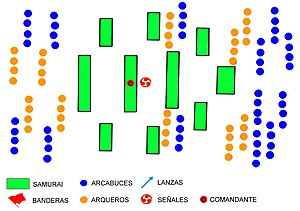
|
| Hoshi (arrowhead) |
An aggressive formation in which the samurai took advantage of the casualties caused by the shooting of the ashigaru. The signaling elements were close to the major generals of the commander. | 
|
| Saku (lock) |
Considered the best defense against the Hoshi,[152] since two rows of arcabuceros and two archers were in position to receive the attack. | 
|
| Kakuyoku (crane wings) |
Recurrent formation with the purpose of surrounding the enemy. The archers and arcabuceros diminished the enemy troops before the melee attack of the samurai while the second company surrounded them. | 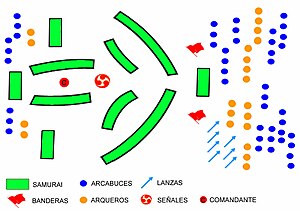
|
| Koyaku (yoke) |
Owes its name to the oxen . It was used to neutralize the "crane wings" and "arrowhead" attack and its purpose was for the vanguard to absorb the first attack and allow time for the enemy to reveal his next move to which the second company could react in time.
|
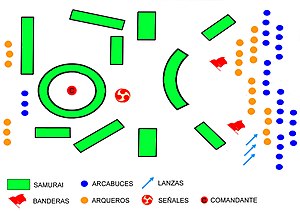
|
| Gyōrin (fish scales) |
Frequently used to deal with much more numerous armies. Its purpose was to attack a single sector to break the enemy ranks. | 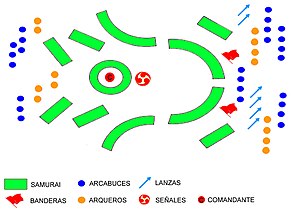
|
| Engetsu (half moon) |
Used when the army was not yet defeated but an orderly withdrawal to the castle was needed. While the rearguard receded, the vanguard could still be organized according to the circumstances. | 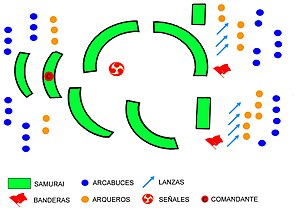
|
Martial arts
Each child who grew up in a samurai family was expected to be a warrior when he grew up, so much of his childhood was spent practicing different martial arts. A complete samurai should be skilled at least in the use of the sword (kenjutsu), the bow and arrow (kyujutsu), the spear (sojutsu, yarijutsu), the halberd (naginatajutsu) and subsequently the use of firearms (houjutsu). Similarly, they were instructed in the use of these weapons while riding a horse. They were also expected to know how to swim and dive.[153]
Nihon Eiho (日本泳法, Japanese swimming style) originates from the
During the feudal era of Japan, various types of martial arts flourished, known in Japanese under the name of bujutsu (武術).[155] The term jutsu can be translated as "method", "art" or "technique"[156] and the name that each one has is indicative of the mode or weapon with which they are executed. The combat methods that were developed and perfected are very diverse, among which are:[155]
| With weapons | No weapons | ||
|---|---|---|---|
Important
|
Secondary
|
Collateral
| |
| Archery | War fan art | Chain art and other tools | |
| kyūjutsu | tessenjutsu | kusarijutsu | aiki jujutsu |
| kyūdō | Cane art | kusariganayutsu | chikarakurabe |
| shagei | bōjutsu | manrikikusari | chogusoku |
| Spear and halberd | jōdō | chigirigijutsu | genkotsu |
| sōjutsu | kanabo /tetsubo jutsu
|
gegikanjutsu | gusoku |
| naginatajutsu | Jitte art | Hidden arts | hakushi |
| sodegaramijutsu | juttejutsu | kyusho Jitsu (Touch of Death) | jūjutsu
|
| sasumatajutsu | toiri-no-jutsu | kenpō o karate | |
| kiaijutsu | |||
| Fencing | chikairi-no-jutsu | kogusoku | |
| tōjutsu | koshi-no-mawari | ||
| kenjutsu | yubijutsu | kumiuchi | |
| koppō | roikomiuchi | ||
| iaijutsu | fukihari | shikaku | |
iaidō
|
suihokojutsu | ||
| tantōjutsu | shubaku | ||
| Horse riding | sumai | ||
| bajutsu | sumo | ||
| jobajutsu | taidō | ||
| suibajutsu | taidōjutsu | ||
| Swimming | torite | ||
| suijutsu[154] | wajutsu | ||
| oyogijutsu | yawara | ||
| katchu gozen oyogi[154] | |||
| Tachi-oyogi[154] | |||
| Ina-tobi[154] | |||
Today martial arts are classified in koryū budō or classical martial arts, before the 19th century, and to the modernization of Japan. Modern traditional martial arts are called gendai budō.
Myth and reality
Most samurai were bound by a code of honor and were expected to set an example for those below them. A notable part of their code is seppuku (切腹, seppuku) or hara kiri, which allowed a disgraced samurai to regain his honor by passing into death, where samurai were still beholden to social rules. While there are many romanticized characterizations of samurai behavior such as the writing of Bushido: The Soul of Japan in 1899, studies of kobudō and traditional budō indicate that the samurai were as practical on the battlefield as were any other warriors.[157]
Some writers take issue with the very mention of the term bushido when not used to describe an individual samurai's usage of the word because of how broad and changed the meaning of it has become over time.[158]
Despite the rampant romanticism of the 20th century, samurai could be disloyal and treacherous (e.g., Akechi Mitsuhide), cowardly, brave, or overly loyal (e.g., Kusunoki Masashige). Samurai were usually loyal to their immediate superiors, who in turn allied themselves with higher lords. These loyalties to the higher lords often shifted; for example, the high lords allied under Toyotomi Hideyoshi were served by loyal samurai, but the feudal lords under them could shift their support to Tokugawa, taking their samurai with them. There were, however, also notable instances where samurai would be disloyal to their lord (daimyō), when loyalty to the emperor was seen to have supremacy.[159]
In popular culture
Samurai figures have been the subject for legends, folk tales, dramatic stories (i.e.
Most common are historical works where the protagonist is either a samurai or former samurai (or another rank or position) who possesses considerable martial skill. Eiji Yoshikawa is one of the most famous Japanese historical novelists. His retellings of popular works, including Taiko, Musashi and The Tale of the Heike, are popular among readers for their epic narratives and rich realism in depicting samurai and warrior culture.[citation needed] The samurai have also appeared frequently in Japanese comics (manga) and animation (anime). Examples are Samurai Champloo, Shigurui, Requiem from the Darkness, Muramasa: The Demon Blade, and Afro Samurai. Samurai-like characters are not just restricted to historical settings, and a number of works set in the modern age, and even the future, include characters who live, train and fight like samurai. Some of these works have made their way to the west, where it has been increasing in popularity with America.
In the 21st century, samurai have become more popular in America. Through various media, producers and writers have been capitalizing on the notion that Americans admire the samurai lifestyle. The animated series, Afro Samurai, became well-liked in American popular culture because of its blend of hack-and-slash animation and gritty urban music. Created by
The television series Power Rangers Samurai (adapted from Samurai Sentai Shinkenger) is inspired by the way of the samurai.[162][163]
In the real-time strategy video game Age of Empires II, players can create samurai units (a Japanese civilization unique unit in-game).[164]
Festivals

There are a variety of festivals held in Japan. Some festivals are seasonal celebrations that were adopted from China and imbued with Japanese cultural values and stories.[165] Other festivals in Japan are held where people celebrate historical heroes or commemorate historical events through parades with people dressed as samurai. Some examples of these festivals include the Hagi Jidai Festival, Matsue Warrior Procession, Kenshin Festival, Sendai Aoba Festival, Battle of Sekigahara Festival, and the Shingen-ko Festival.[166]
The Hagi Jidai Festival takes place in the fall in Hagi, Yamaguchi Prefecture. This festival started in the Edo period as a way for the people of Hagi to show their appreciation to the God of Kanaya Tenmangu Shrine.[167] The festival has over 200 people dress up in traditional samurai armor and the clothes of various people of the daimyō's court as they walk down the streets of the town.[168] The festival is separated into two main events: the Hagi Daimyō Procession and the Hagi Jidai Parade. The Hagi Daimyō Procession begins in the morning at the Hagi Castle town area with a procession of samurai, servants, and palanquin bearers marching and performing traditional dances.[168] In the afternoon, the Hagi Jidai Parade occurs, starting in the Central Park and go around the town until they reach the Kanaya Tenmangu Shrine.[168]
The Matsue Warrior Procession is a festival in Matsue, Shimane Prefecture. This festival reenacts the entrance of Daimyō Horio Yoshiharu and his troops into a newly built Matsue during the Edo Period.[169] The event is held on the first Saturday of April.[170] The event is made up of performers marching in a warrior parade at the Shirakata Tenmangu Shrine dressed in samurai armor and various clothing of the Edo period.[170] Visitors are also have the opportunity to rent costumes and march in the parade, or to take pictures with the performers in the parade.[171] Other events also take place throughout the day to celebrate the founding of the city.
The Kenshin Festival is a festival held in
The
Famous samurai

These are some famous samurai with extraordinary achievements in history.
- Akechi Mitsuhide
- Amakusa Shirō
- Date Masamune
- Hasekura Tsunenaga
- Hattori Hanzō
- Hōjō Ujimasa
- Honda Tadakatsu
- Kusunoki Masashige
- Minamoto no Yoshitsune
- Minamoto no Yoshiie
- Miyamoto Musashi
- Nakano Takeko
- Oda Nobunaga
- Saigō Takamori
- Saitō Hajime
- Sakamoto Ryōma
- Sanada Yukimura
- Sasaki Kojirō
- Shimazu Takahisa
- Shimazu Yoshihiro
- Takayama Ukon
- Takeda Shingen
- Tokugawa Ieyasu
- William Adams
- Toyotomi Hideyoshi
- Uesugi Kenshin
- Yagyū Jūbei Mitsuyoshi
- Yagyū Munenori
- Yamamoto Tsunetomo
- Yamaoka Tesshū
Samurai museums
- Matsumoto Castle – the second floor features a collection of feudal guns, armor, and other weapons.
- Japanese Sword Museum – dedicated to the art of Japanese swordmaking.
- Samurai Museum in Shinjuku, Tokyo – about the history of the samurai with armor, weapons etc.
- Ōyamazumi Shrine in Ōmishima Island – large collection of ancient samurai weaponry, armor and shrine statuary.
See also
References
- ISBN 978-0-8047-7962-3. Retrieved 18 July 2022 – via Google Books.
- ISBN 978-0-8047-6478-0. Retrieved 18 July 2022 – via Google Books.
- ISBN 978-0-674-01557-9. Retrieved 18 July 2022 – via Google Books.
- ISBN 978-0-8264-6074-5. Retrieved 18 July 2022 – via Google Books.
- ^ Samurai: The Story of a Warrior Tradition, Harry Cook, Blandford Press 1993, ISBN 0713724323
- ^ MartialArtSwords.com. "Common Myths and Misconceptions About Traditional Japanese Daishō". MartialArtSwords.com. Retrieved 28 June 2023.
- OCLC 1202732830.
- OCLC 634240939.
- Tōkyō: Shogakukan
- ISBN 4-09-501211-0
- ISBN 4-385-13905-9
- ^ 1603, Nippo Jisho ("Japanese-Portuguese Dictionary"). Entry for saburai, the then-current pronunciation of modern samurai. Accessed 2022-06-06.
- ^ 1603, Nippo Jisho ("Japanese-Portuguese Dictionary"). Entry for buxi, the then-current romanization of modern bushi. Accessed 2022-06-06.
- ^ "Samurai (Japanese warrior) Archived 2009-09-29 at the Wayback Machine". Encyclopædia Britannica.
- ^ ISBN 0-674-38704-X
- ^ A History of Japan, Vol. 3 and 4, George Samson, Tuttle Publishing, 2000.
- ^ Daijirin, second edition, 1995
- ^ Nihon Kokugo Daijiten, entry for saburau available online here [1] (in Japanese)
- ^ Shin Meikai Kokugo Jiten, fifth edition, 1997
- ^ Digital Daijisen, entries for samurai and saburai available online here [2] (in Japanese)
- ^ "Aristocratic Control, The Heian Aristocracy, History, Japan, Asia – Taika reforms, clan chieftain, sesshu, shoen, land redistribution". www.countriesquest.com. Archived from the original on 12 February 2017.
- ^ a b 平将門の乱は何が原因? 平将門の生涯や、事件の背景、その後の影響を解説 (in Japanese). Shogakukan. 8 November 2022. Archived from the original on 13 March 2024. Retrieved 14 March 2024.
- ^ 平将門 (in Japanese). The Nagoya Japanese Sword Museum Nagoya Touken World. Archived from the original on 14 March 2024. Retrieved 14 March 2024.
- ^ a b 式正の鎧・大鎧 Costume Museum
- ^ a b 【藤原道長はなぜ躍進?】摂関政治をわかりやすく説明する方法 (in Japanese). Tomonokai. 19 July 2015. Archived from the original on 11 May 2022. Retrieved 11 March 2024.
- ^ a b 摂関政治で最盛期を築き上げた藤原氏とは、いかなる由緒を持つ氏族なのか (in Japanese). Yahoo News. 4 January 2024. Archived from the original on 12 March 2024. Retrieved 12 March 2024.
- ^ a b 摂関政治 (in Japanese). Kotobank. Archived from the original on 29 November 2023. Retrieved 13 March 2024.
- ^ a b 平氏政権の登場 (PDF) (in Japanese). NHK. Archived from the original (PDF) on 14 March 2024. Retrieved 14 March 2024.
- ^ 頼朝のライバル木曽義仲がた辿った生涯と人物像に迫る 源平合戦で活躍したその武略とは? (in Japanese). Kotobank. 3 April 2022. Archived from the original on 1 December 2023. Retrieved 13 March 2024.
- ^ 鎌倉幕府は何年に成立?正解を言えますか (in Japanese). Toyo keizai. 9 June 2016. Archived from the original on 9 May 2022. Retrieved 9 March 2024.
- ^ Wilson, p. 15
- ISBN 4-7700-2754-0.
- ISBN 978-1-60153-123-0.
- ^ 胴丸・腹当・腹巻. Nagoya Japanese Sword Museum Nagoya Touken World.
- ^ Reed, Sir Edward James (17 April 1880). Japan: Its History, Traditions, and Religions: With the Narrative of a Visit in 1879. J. Murray. p. 291 – via Internet Archive.
tokimune behead.
- ^ "常立寺". www.kamakura-burabura.com.
- ^ "Formative Memory: The Thirteenth-Century Mongolian Invasions and Their Impact on Japan". Kyoto Journal. 26 April 2017. Retrieved 25 October 2020.
- ^ 天皇陵. Imperial Household Agency
- ^ a b 守護大名と戦国武将 (in Japanese). The Japanese Sword Museum Nagoya Touken World. Archived from the original on 17 March 2024. Retrieved 17 March 2024.
- ^ 日本刀の歴史 南北朝時代 Touken world
- ^ a b c 歴史人 September 2020. pp.40–41. ASIN B08DGRWN98
- ISBN 978-4-651-20040-8
- ^ 甲冑の歴史(南北朝時代~室町時代) Nagoya Japanese Sword Museum Nagoya Touken World.
- Shōgakukan. Archived from the originalon 31 January 2023. Retrieved 31 January 2023.
- ^ 戦国時代 (in Japanese). Japan Knowledge. Archived from the original on 6 December 2022. Retrieved 29 January 2023.
- ^ 意外と知らない「下剋上」とは一体何か?戦国時代の「主殺し」の実像 3/4 (in Japanese). Kodansha. 18 June 2021. Archived from the original on 7 March 2024. Retrieved 7 March 2024.
- ^ 意外と知らない「下剋上」とは一体何か?戦国時代の「主殺し」の実像 4/4 (in Japanese). Kodansha. 18 June 2021. Archived from the original on 7 March 2024. Retrieved 7 March 2024.
- ^ 守護大名と戦国武将の違い (in Japanese). The Japanese Sword Museum Nagoya Touken World. Archived from the original on 17 March 2024. Retrieved 17 March 2024.
- ^ 豊臣秀吉はなぜ「征夷大将軍」ではなく「関白」になったのか――秀吉をめぐる「三つのなぜ」 (in Japanese). The Asahi Shimbun. 24 September 2023. Archived from the original on 29 February 2024. Retrieved 29 February 2024.
- ISBN 978-0-87923-773-8. Retrieved 22 September 2011.
- ^ Basic knowledge of naginata and nagamaki. Nagoya Japanese Sword Museum, Touken World
- ^ Arms for battle – spears, swords, bows. Nagoya Japanese Sword Museum, Touken World
- ISBN 978-4-651-20040-8
- ISBN 978-4-651-20040-8
- ^ a b c 日本の甲冑 Costume Museum
- ^ ISBN 978-4-8053-1389-3.
- ^ OCLC 1202732830.
- ^ a b Cartwright, Mark (5 July 2019). "Samurai". World History Encyclopedia. Retrieved 18 April 2024.
- ^ a b Grabianowski, Ed; Pollette, Chris (10 June 2022). "How Samurai Work". HowStuffWorks. Retrieved 18 April 2024.
- ^ OCLC 1091716966.
- ^ Mancini, Mark (11 February 2020). "What's the Difference Between a Samurai and a Ninja?". HowStuffWorks. Retrieved 18 April 2024.
- ^ ISBN 0-8160-5622-6.
- ^ 安土桃山時代 (in Japanese). Kotobank. Archived from the original on 25 December 2023. Retrieved 9 March 2024.
- ^ Nagano Prefectural Museum of History (1 March 2005). "たたかう人びと". Comprehensive Database of Archaeological Site Reports in Japan. Retrieved 2 September 2016.
- ISBN 978-90-04-48918-9.
- ^ Yasuka (24 July 2017). "The Imjin War | KCP International Japanese Language School". KCP International. Retrieved 28 June 2023.
Hideyoshi needed passage through Korea to get to China. But with Korea refusing his demands, he led a large army of about 160,000 men, landing at the tip of the peninsula then moving northwards.
- ^ Cartwright, Mark. "The Japanese Invasion of Korea, 1592-8 CE". World History Encyclopedia. Retrieved 28 June 2023.
One of the largest military operations ever undertaken in East Asia prior to the 20th century CE
- ^ "What is the Imjin War (1592-1598)? - Boot Camp & Military Fitness Institute". bootcampmilitaryfitnessinstitute.com. 16 December 2020. Retrieved 28 June 2023.
- ^ Cartwright, Mark. "The Japanese Invasion of Korea, 1592-8 CE". World History Encyclopedia. Retrieved 28 June 2023.
After protracted and unsuccessful peace talks, Hideyoshi launched a second, much less successful invasion in 1597 CE, and when the warlord died the next year, the Japanese forces withdrew from the peninsula.
- ^ a b 関ヶ原の戦い (in Japanese). National Archives of Japan. Archived from the original on 8 January 2023. Retrieved 9 March 2024.
- ^ a b 豊臣秀次 (in Japanese). Japan Knowledge. Archived from the original on 27 March 2023. Retrieved 10 March 2024.
- ^ a b 新説!豊臣家を滅ぼした「組織運営」の大失敗 (in Japanese). Toyo Keizai. 22 May 2016. Archived from the original on 21 April 2021. Retrieved 10 March 2024.
- ^ a b どうして豊臣政権は短命だったのか?存続のカギは弟・豊臣秀長が握っていた (in Japanese). Yahoo News. 1 September 2023. Archived from the original on 10 March 2024. Retrieved 10 March 2024.
- ISBN 0-7614-0304-3.
- ^ "Japanese Mercenaries and the Dutch East India Company". World History Commons. Archived from the original on 8 February 2023. Retrieved 14 February 2024.
- ^ Relationship of Japan and the Netherlands in Asia Market in 17th Century and Today (in Japanese). Wako University/J Stage. p. 61-67. Archived from the original on 14 February 2024. Retrieved 14 February 2024.
- ^ 「異国で王になった男」山田長政. The Hiroshima Bank (in Japanese). Archived from the original on 24 August 2022. Retrieved 14 February 2024.
- ^ 天正遣欧使節 (in Japanese). Kotobank. Archived from the original on 15 February 2024. Retrieved 15 February 2024.
- ^ "Faithful legacy of the 'samurai ambassador'". 16 March 2021. Archived from the original on 28 November 2023. Retrieved 15 February 2024.
- ^ 世界を見たサムライ達 (in Japanese). National Diet Library. Archived from the original on 23 February 2023. Retrieved 15 February 2024.
- ^ Harry D. Harootunian, "The progress of Japan and the Samurai class, 1868–1882." Pacific Historical Review (1959) 28#3: 255–266. online
- ^ Harry D. Harootunian, "The Economic Rehabilitation of the Samurai in the Early Meiji Period." Journal of Asian Studies 19.4 (1960): 433–444. online
- ^ James L. Huffman, "The Meiji Roots and Contemporary Practices of the Japanese Press," The Japan Interpreter (Spring 1977): 448–466.
- ^ Andrew Cobbing, The Satsuma Students in Britain: Japan's Early Search for the essence of the West (1998), ch. 4.
- ^ Mansel G. Blackford. The Rise of Modern Business in Great Britain, the United States, and Japan (3rd ed.). U of North Carolina Press. p. 122. Archived from the original on 7 August 2020. Retrieved 18 November 2019.
- ^ Sharf 1993, p. 12.
- ^ Coleridge, p. 237
- ^ Wilson, p. 38
- ^ Carl Steenstrup, PhD Thesis, University of Copenhagen (1979)
- ^ Wilson, p. 47
- ^ "Excerpts from Articles of Admonition by Imagawa Ryoshun to his son Nakaai" (PDF).
- ^ Wilson, p. 62
- ^ Wilson, p. 103
- ^ Wilson, p. 95
- ^ Wilson, p. 67
- ^ Wilson, p, 131
- ISBN 978-4-87378-389-5.
- ISBN 978-0-7674-2011-2.
- ^ "Last Statement".[dead link]
- ^ Wilson, p. 122
- ^ Wilson, p. 91
- ISBN 978-0-691-01770-9.
- ISBN 978-0-691-01770-9.
- ISBN 978-0-8248-2152-4.
- ^ Coleridge, p. 100
- ^ a b Matsura, Yoshinori Fukuiken-shi 2 (Tokyo: Sanshusha, 1921)
- ISBN 978-0-495-50262-3.
- ^ a b Wilson, p. 26
- ^ Wilson [page needed]
- ISBN 978-0-8048-2097-4.
- Skyhorse Pub.; Chicago : ALA Editions, 2009. p. 113 [ISBN missing]
- ^ Wilson, p. 85
- ^ Coleridge, p. 345
- ISBN 978-0-19-093294-7.
- ^ Michael (4 May 2022) "Land of the Tiger's Mouths: Understanding the Iga-Kōga Phenomenon & the Birth of the Ninja". The Historian's Craft. 7:04, 10:05.
- ISBN 978-1-78096-333-4.
- ^ "William Adams and Early English Enterprise in Japan" (PDF). Suntory and Toyota International Centres for Economics and Related Disciplines (part of the London School of Economics and Political Science). Archived (PDF) from the original on 8 August 2017. Retrieved 1 March 2017.
- ^ "松平家忠、「家忠日記」、文科大学史誌叢書第2巻、吉川半七、1897年、54頁". Retrieved 4 August 2015.
- ^ 『織田信長という歴史 『信長記』の彼方へ』、勉誠出版、2009年、311-312頁。
- ISBN 978-4-8419-1000-1
- ^ "The Real Life of "Silence's" Character". 2 May 2017.
- ^ "The Real Life of "Silence's" Character". District of the USA. 2 May 2017. Retrieved 28 June 2023.
- ISBN 978-0-415-32963-7.
- ^ Turnbull, Stephen. Samurai The Story of Japan's Great Warriors. London. Prc Publishing Ltd., 2004. [page needed][ISBN missing]
- ISBN 978-0-7360-5542-0.
- ISBN 978-1-4027-6312-0.
- ^ Turnbull, Stephen. Samurai The Story of Japan's Great Warriors. London. Prc Publishing Ltd, 2004. p. 174. [ISBN missing]
- ISBN 978-4-8053-0956-8.
- ISBN 978-1-4728-2224-6.
- ^ ISBN 978-1-873410-38-7.
- ^ Turnbull, Stephen. Samurai The Story of Japan's Great Warriors. London. Prc Publishing Ltd., 2004. p. 137.
- ]
- ISBN 978-0-19-533126-4.
- ^ Turnbull, Stephen. Samurai The Story of Japan's Great Warriors. London. Prc Publishing Ltd., 2004. p. 139
- ^ "Japanese Arms and Armour". Pitt Rivers Museum. 2007. "Learning Resources". Archived from the original on 18 April 2018. Retrieved 17 April 2017.
- ^ Turnbull, Stephen. Samurai The Story of Japan's Great Warriors. London. Prc Publishing Ltd., 2004. Print.
- ISBN 978-0-8048-1684-7.
- ISBN 978-1-59228-720-8.
- ^ The connoisseur's book of Japanese swords, Kōkan Nagayama, Kodansha International, 1998 p. 43
- ^ a b Turnbull, Stephen. Samurai The Story of Japan's Great Warriors. London. Prc Publishing Ltd, 2004. p. 196.
- ^ a b Turnbull, Stephen. Samurai The Story of Japan's Great Warriors. London. Prc Publishing Ltd, 2004. p. 208.
- ^ Turnbull, Stephen. Samurai The Story of Japan's Great Warriors. London. Prc Publishing Ltd, 2004. p. 207.
- ^ Turnbull, Stephen. Samurai The Story of Japan's Great Warriors. London. Prc Publishing Ltd, 2004. p. 209.
- ISBN 84-9763-140-4. p. 57.
- ^ Turnbull, Stephen. Samurai The Story of Japan's Great Warriors. London. Prc Publishing Ltd, 2004. p. 198.
- ^ ISBN 84-9763-140-4. p. 56.
- ^ a b Turnbull, Stephen. Samurai The Story of Japan's Great Warriors. London. Prc Publishing Ltd., 2004. p. 231.
- ^ ISBN 4-569-66651-5.
- ISBN 84-9763-140-4. p. 114.
- ISBN 0-85045-302-X. p. 12
- ISBN 0-85045-302-X. p. 10
- ISBN 1-84176-740-9. p. 14.
- ^ a b c d e f g h i j k Taylor Shortal (9 August 2020). "The modern Japanese sport of samurai swimming". Pulp Sage. Archived from the original on 29 August 2021. Retrieved 20 November 2021.
- ^ ISBN 8-48019-492-8. p. 24.
- ISBN 8-48019-492-8. p. 23.
- ^ David "Race" Bannon, "The Dawn of the Samurai: Warrior Legends in Japanese History", Asian Pacific Quarterly, Vol 26, No 2 (1994): 38-47.
- ^ Rich (8 December 2014). "Bushido: Way of Total Bullshit". Tofugu. Retrieved 2 March 2023.
- ^ Mark Ravina, The Last Samurai – The Life and Battles of Saigō Takamori, John Wiley & Sons, 2004.
- ^ Roland Thorne, Samurai films (Oldcastle Books, 2010).
- ^ Charles Solomon, "Way of the sword" Los Angeles Times Feb 2, 2009
- ^ *Marc Buxton (26 July 2013). "Villains of The Wolverine: Silver Samurai and Viper". Den of Geek. Archived from the original on 9 January 2015.
- Denison, Rayna (27 May 2011). "Transcultural creativity in anime: Hybrid identities in the production, distribution, texts and fandom of Japanese anime". Creative Industries Journal. 3 (3): 221–235. S2CID 143210545.
- King, Kevin (1 December 2008). "Afro Samurai". Youth Graphic Novels in Brief. Booklist. Vol. 105, no. 7. p. 44. ProQuest 235647197.
- Manion, Annie (August 2006). "Global Samurai" (PDF). Japan Railway & Transport Review. pp. 46–47. Archived from the original (PDF) on 11 September 2010.
- Denison, Rayna (27 May 2011). "Transcultural creativity in anime: Hybrid identities in the production, distribution, texts and fandom of Japanese anime". Creative Industries Journal. 3 (3): 221–235.
- ^ *Moscardi, Nino. "The "Badass" Samurai in Japanese Pop Culture". Samurai-Archives. Archived from the original on 19 March 2014.
- Ravina, Mark (1 October 2010). "Fantasies of Valor: Legends of the Samurai in Japan and the United States". ASIANetwork Exchange. 18 (1): 80–99. ]
- Solomon, Charles (2 February 2009). "American, Japanese pop culture meld in 'Afro Samurai'". Los Angeles Times. Archived from the original on 18 January 2015.
- ^ "Japanese – Forgotten Empires". www.forgottenempires.net. Retrieved 4 July 2022.
- ISSN 1743-9213. Archived from the original on 27 July 2018. Retrieved 29 March 2024.)
{{cite journal}}: CS1 maint: bot: original URL status unknown (link - ^ "Experience the samurai world through historic festivals across Japan – ANA". www.ana.co.jp. Retrieved 30 November 2020.
- ^ "Hagi Jidai Festival in Yamaguchi – Experience as if You Were in Edo Period". FestivalGo. Archived from the original on 15 April 2021. Retrieved 30 November 2020.
- ^ a b c "Seasonal Features – HAGI – Sightseeing Guide". HAGI – Sightseeing Guide|Hagi, Yamaguchi, Japan. Retrieved 30 November 2020.
- ^ "VISIT MATSUE – Events|April|Matsue Musha Gyoretsu Warrior Parade – 松江武者行列". www.visit-matsue.com. Retrieved 30 November 2020.
- ^ a b "April/May/June Events". Matsue Travel Guide (in French). 19 June 2014. Retrieved 30 November 2020.
- ^ Calendar, Japanese Traditional Festival (30 November 2020). "Matsue Warrior Procession". ohmatsuri.com. Retrieved 30 November 2020.
- ^ a b Calendar, Japanese Traditional Festival (30 November 2020). "Kenshin Festival". ohmatsuri.com. Retrieved 30 November 2020.
- ^ "Lord Kenshin Festival – 上越観光Navi". joetsukankonavi.jp. Retrieved 30 November 2020.
- ^ "[2020 reduction holding] Prince the 95th Kenshin festival | National must-see-japan (Japanese sightseeing promotion association)". en.nks.iamdn.com.e.wp.hp.transer.com. Archived from the original on 15 April 2021. Retrieved 30 November 2020.
- ^ "Niigata Travel | Kenshin Festival". WOW U Japan. Retrieved 30 November 2020.
- ^ Kofu City, ed. (1 January 2009), Shingen-Ko Festival – Celebrating the Legacy of Takeda Shingen (PDF) (in Japanese), Yamanashi Tourism Promotion Organization, archived from the original (PDF) on 29 September 2018, retrieved 18 June 2019
- ^ "Shingen-ko Festival". 【公式】富士の国やまなし観光ネット 山梨県公式観光情報. "Shingen-ko Festival" Executive Planning Committee. 1 February 2019. Archived from the original on 31 March 2019. Retrieved 19 June 2019.
Bibliography
- Absolon, Trevor. Samurai Armour: Volume I: The Japanese Cuirass (Bloomsbury Publishing, 2017).[ISBN missing]
- Anderson, Patricia E. "Roles of Samurai Women: Social Norms and Inner Conflicts During Japan's Tokugawa Period, 1603–1868". New Views on Gender 15 (2015): 30–37. online
- Ansart, Olivier. "Lust, Commerce and Corruption: An Account of What I Have Seen and Heard by an Edo Samurai". Asian Studies Review 39.3 (2015): 529–530.
- Benesch, Oleg. Inventing the Way of the Samurai: Nationalism, Internationalism, and Bushido in Modern Japan (Oxford UP, 2014). ISBN 978-0-19-870662-5
- Benesch, Oleg. "Comparing Warrior Traditions: How the Janissaries and Samurai Maintained Their Status and Privileges During Centuries of Peace." Comparative Civilizations Review 55.55 (2006): 6:37–55 Online.
- Clements, Jonathan. A Brief History of the Samurai (Running Press, 2010) ISBN 0-7624-3850-9
- ISBN 978-1-4510-0048-1.
- Cummins, Antony, and Mieko Koizumi. The Lost Samurai School (North Atlantic Books, 2016) 17th century Samurai [ISBN missing] textbook on combat; heavily illustrated.
- Hubbard, Ben. The Samurai Warrior: The Golden Age of Japan's Elite Warriors 1560–1615 (Amber Books, 2015).[ISBN missing]
- Jaundrill, D. Colin. Samurai to Soldier: Remaking Military Service in Nineteenth-Century Japan (Cornell UP, 2016).[ISBN missing]
- Kinmonth, Earl H. Self-Made Man in Meiji Japanese Thought: From Samurai to Salary Man (1981) 385pp.[ISBN missing]
- Ogata, Ken. "End of the Samurai: A Study of Deinstitutionalization Processes". Academy of Management Proceedings Vol. 2015. No. 1.
- Sharf, Robert H. (August 1993). "The Zen of Japanese Nationalism". History of Religions. 33 (1). S2CID 161535877.
- Thorne, Roland. Samurai films (Oldcastle Books, 2010).[ISBN missing]
- Turnbull, Stephen. The Samurai: A Military History (1996).[ISBN missing]
- Kure, Mitsuo. Samurai: an illustrated history (2014).[ISBN missing]
- ISBN 0-89750-081-4.
Historiography
- Howland, Douglas R. "Samurai status, class, and bureaucracy: A historiographical essay". .
External links
 Media related to Samurai at Wikimedia Commons
Media related to Samurai at Wikimedia Commons- The Samurai Archives Japanese History page
- Samurai Swords and Samurai Culture Archived 28 April 2019 at the Wayback Machine
- History of the Samurai
- The Way of the Samurai – Japan: Memoirs of a Secret Empire
- Comprehensive Database of Archaeological Site Reports in Japan, Nara National Research Institute for Cultural Properties


